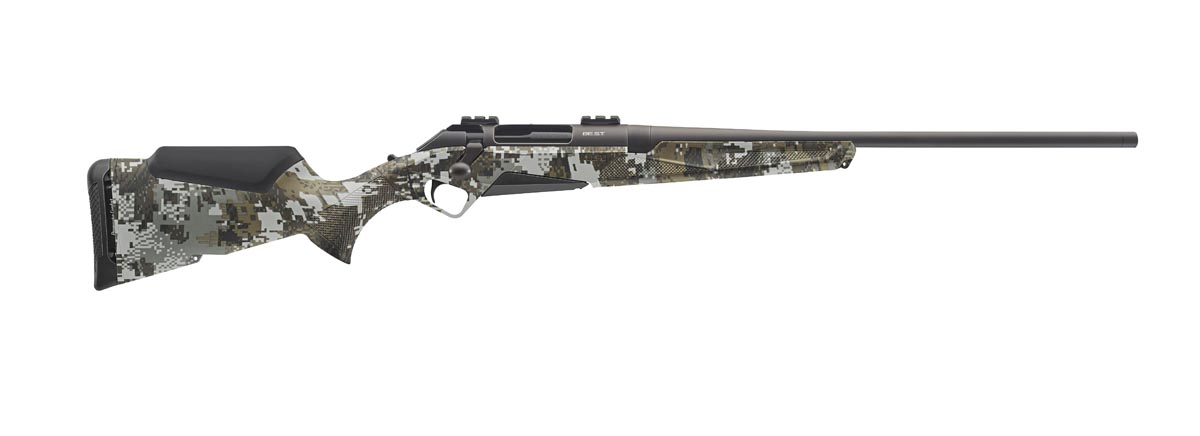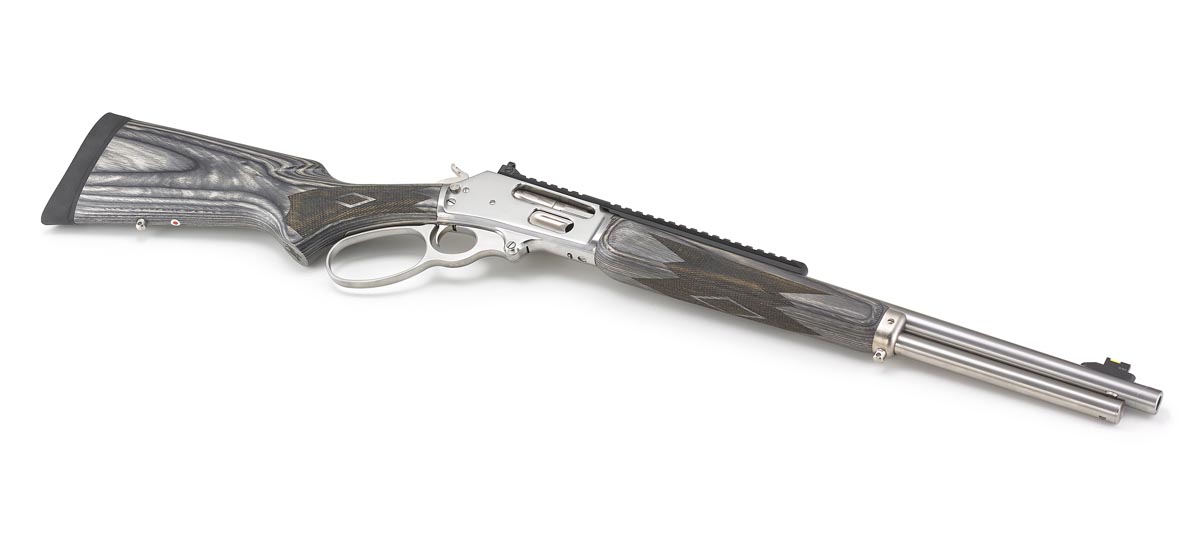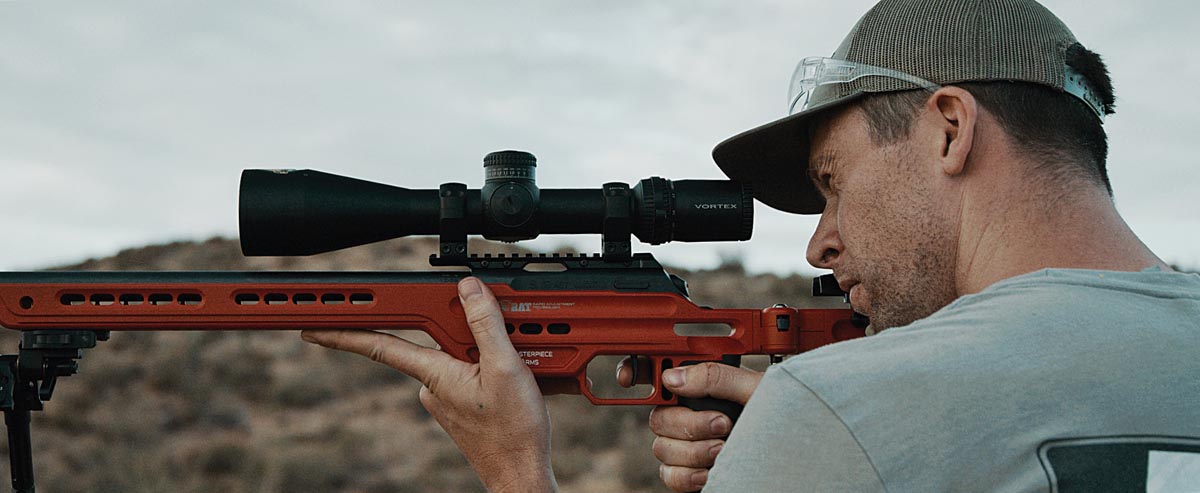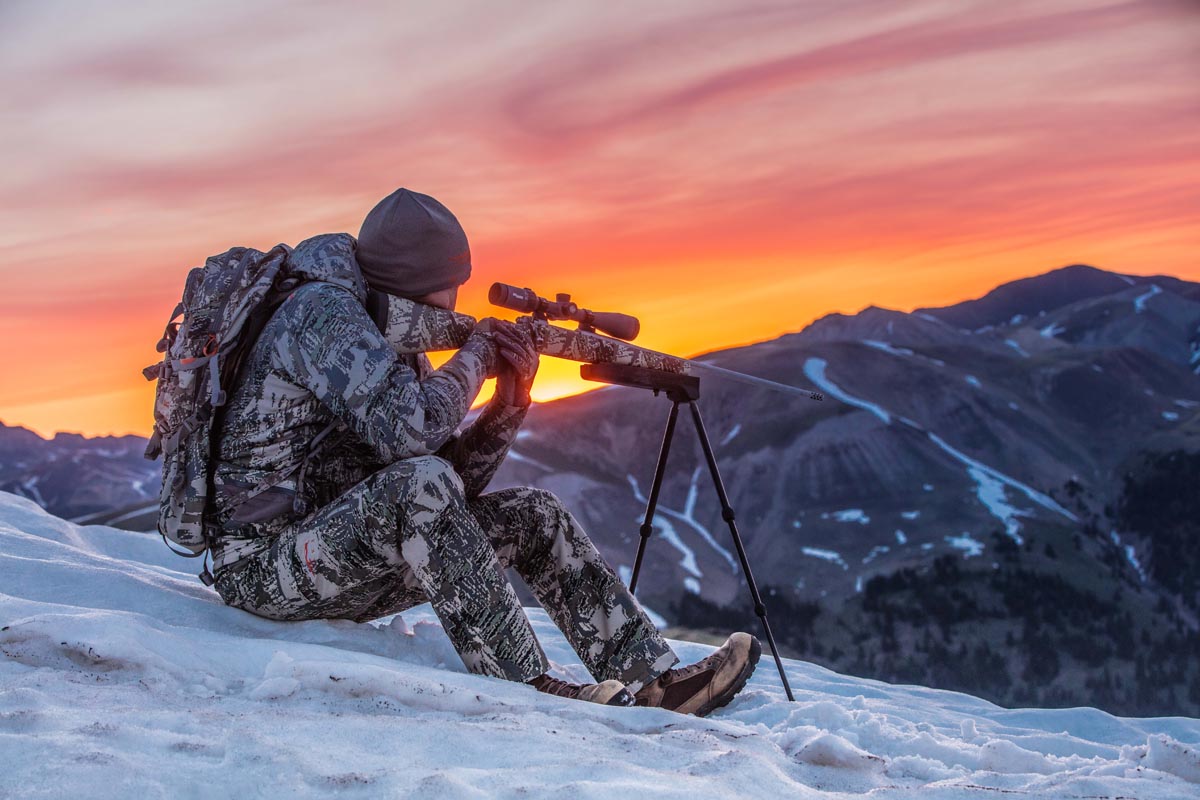by Wayne van Zwoll and Brad Fitzpatrick
Whether you’ve drawn that once-in-a-lifetime bull tag or are simply hunting to fill the freezer, these guns will get the job done.
Wayne’s Picks:
One of RMEF’s first field directors and an early life member, Wayne van Zwoll is widely published on rifles and big game hunting. Here are four rifles he thinks deserve a good look if you’re ready to try something new:

Kimber 84M
Heavy snow bowed the alders and lay thick on conifer limbs. I was sopping wet. But saucer-size prints drew me on and up. The bull had joined a herd. When bright slits between trees became an opening, I held to trail’s side lest elk be watching back. Stopping inside timber, I saw the cow too late. The second-growth came alive. I spied antlers, fired, caught them again, sent a follow-up. The crashing subsided. My prize lay behind snow-draped boughs.
I can’t name a better elk rifle than the Kimber in hand that day, a trim 84M in .338 Federal with a 1.5-5x Leupold. It’s the original 84, built/sized for .308-length cartridges. The first 84M I tested weighed less than 6 pounds and shot a .7-inch group. I bought it. Kimber rifles have an adjustable trigger, a three-position safety, a Mauser claw for controlled feeding from a five-shot internal box over a steel floorplate.
After a change of ownership and the debut of Kimber 1911 pistols, production went to New York. Now, after 21 years, Kimber has moved to Troy, Alabama. A 225,000-square-foot building houses all operations. Of 17 hunting rifles, the SuperAmerica, Classic Select and Varmint feature walnut stocks and sight-free, unthreaded barrels. Other Kimbers have hand-laid carbon fiber stocks and threaded barrels: blued, stainless and CF. The stock on the 6½-pound Hunter—the only Kimber with a detachable box—is of molded polymer. In .375 H&H, the Caprivi (walnut) and Talkeetna (composite) wear open sights. Learn more at Kimberamerica.com.
 Taylor’s & Co. Winchester 1886
Taylor’s & Co. Winchester 1886
In my youth, many deer and elk hunters used lever-actions. Popular models cost about $90, while equivalent bolt rifles rang up at $150. CNC machines have since made bolt-actions cheaper to build. The hand labor required to fit and time lever-actions has buoyed their price. More’s the pity!
Last fall I carried a modern version of the John Browning-designed Winchester 1886. Imported by Taylor’s & Co., it’s true to the original in action profile and cycles as smoothly. But Taylor’s tweaked it for the times. The stock of well-checkered walnut is beefier at wrist and forend. Receiver and oversize lever are beautifully case-colored. The thick 16½-inch blued barrel is octagonal to the forend cap, round to the threaded muzzle. A Picatinny rail accepts a barrel-mounted scope, though the Skinner aperture and fiber-optic bead helped me keep 325-grain Hornady FTX bullets in groups nudging a minute of angle. In a South Dakota bottom last November, I came upon a whitetail buck that paused just long enough for this .45-70 to reach my cheek. I fired offhand. He dashed off, flag low, collapsing short seconds later.
Taylor’s & Co. was started in 1988 by Sue Hawkins McFarland after she’d worked her way to a management post in Italy’s firearms industry. With daughter Tammy Loy, she’s now “keeping the legend alive” with high-quality reproduction firearms from Uberti, Pietta, Pedersoli, Chiappa and other respected makers. Those I’ve examined are as nicely fitted and finished as the 1886 Winchester remake that served me last fall. Taylor’s carries accessories too, even period-correct Malcolm scopes! See more at Taylorsfirearms.com.
 Tikka T3x
Tikka T3x
On a frosty Finnish dawn, I eased into waist-high swamp grass. A cow moose rose. Sunlit steam blew into shadow beyond at the shot. She spun and galloped past. I leaped deadfall, spied a slot ahead. By great luck, the bull took that trail, and turned. He dropped to the blast. Tikka rifles have been kind to me.
Founded in 1893, Tikka turned its focus to hunting rifles after WW II, collaborating with another Finnish company, Sako, on a Model 555 bolt-action. Later Sako acquired Tikka. By 1989 production at Tikkakoski Works had moved to Sako’s Riihimaki plant. Tikka sold its Whitetail rifle stateside during the 1990s, then introduced the T3. At its 2003 debut, the T3 impressed me for its simplicity, balance in hand, and silky cycling. Bolt stops suited this action to various cartridge lengths. A detachable polymer magazine – lightweight, but sturdy – fed the rifle. Sako’s hammer-forged barrels made it accurate.
In 2016 Tikka updated its T3 with the T3x, tweaking only what could be improved. For ‘22, Tikka lists 19 versions of the T3x, four with brakes. All have an enlarged port for easier single loading. A foam insert in hollow synthetic stocks quiets them in the woods. Modular inserts at grip and forend better adapt them to your hands and shooting style; a new recoil pad babies your clavicle. The receiver more readily accepts a Picatinny rail, should you prefer it to the integral dovetails (I don’t). Of this line, the T3x Hunter with unthreaded blued or stainless barrel (fluted or not) most appeals to me. Its 20 chamberings include two I adore but seldom see: the 8×58 IS and 9.3×62. Need an understudy rifle? The T1x in .22 LR and .17 HMR all but duplicates the T3x in fit and feel. Tikka is a Beretta brand. See more at www.tikka.fi/en-us.
 Weatherby Mark V Backcountry
Weatherby Mark V Backcountry
A tan spot in charred ‘poles on a stony steep became an elk. The herd numbered many cows, well scattered. The fire had left no ground cover. The bull was still over 300 yards off when no further advance was tenable. Slinged up prone, I held a hand’s-width high and crushed the trigger. Thwuck! The bull sped away, blinks between boles. Then came the crash. The .270 Weatherby still ranks among my favorite elk cartridges; so too the 7mm Weatherby that killed a six-point in his bed at 14 steps.
I’ve shot other elk with Weatherbys, most near enough to leave the long reach of these magnums untapped, the first of which appeared in the early 1940s. Better to have it and not need it than need it and not have it!
The Mark V with nine interrupted-thread locking lugs arrived in 1958—a rifle to handle the .378 and .460. It served for lesser magnums but was too long and heavy for standard rounds. In ’63, Weatherby trotted out a trim, six-lug variant for the .30-06 and kin. I bought a .25-06. It brought me a fine whitetail. Soon after the company’s recent move from California to Wyoming, this lightweight Mark V got a new Weatherby chambering: 6.5 RPM (Rebated Precision Magnum). Its case is tailored to the six-lug action. A rebated rim fits standard (.473) bolt faces. “We get over 3,000 fps from 140-grain bullets,” says Adam Weatherby. “They bring 1,500 ft-lbs over a quarter mile!” Unlike other Weatherby Magnums, the RPM has no belt, no radiused shoulder. The rifle has no “freebore”—the long throat that helped Roy throttle pressures. Scaling just six pounds, the Mark V Backcountry in 6.5 RPM excels where long hikes and long shots are the rule. Hunters have taken note. “Historically, 20 percent of Mark Vs sold were six-lug rifles,” Adam tells me.” Now they’re as popular as Mark V Magnums.” See more at Weatherby.com.

Browning
My memories of Browning rifles start with the FN-built High Power of the 1960s. In 1985 it was supplanted by the three-lug A-Bolt. Nine years later came the A-Bolt II, with an anti-bind bolt and a better trigger. The X-Bolt and a three-lever Feather Trigger appeared in 2008. Still Browning’s flagship hunting rifle, the X-Bolt includes 13 new versions for 2022, all braked, in Smoked Bronze Cerakoting. The Speed series chambers 16 cartridges, .243 to .300 RUM. Two Hells Canyon (long-range) rifles feature extended bolt knobs and McMillan Game Scout stocks.
X-Bolt rifles I’ve benched have shot tight groups. They cycle fast, courtesy of a 60-degree bolt lift, and the tang safety is a boon to lefties. (Browning’s cartridge list for the fetching walnut-stocked Hunter left-bolt rifle has 13 entries!) The detachable box fits flush. On plains-game hunts in Africa and for elk in the Mountain West, X-Bolts have carried easily, pointed naturally, functioned without fault, maintained point of impact. Visit Browning.com.
 Alterra
Alterra
Sub-.25-inch three-shot groups with custom loads, .50-inch with factory ammo? AllTerra, founded in 2015, backs its boasts with a CNC-machined stainless action featuring EDM-cut races and bolt-to-bore alignment tolerances of .0005 inch. Sleeves fore and aft of the barrel thread snug into the receiver ring. A nickel-boron-plated bolt has an M16-type extractor and dual ejectors. The magazine is a generous internal box with floorplate (hooray!). Each pillar-bedded hunting rifle produced by this Idaho company wears a TriggerTech trigger and a proprietary Carbon Hunter stock. Hand-lapped carbon fiber barrels trim overall weight to around six pounds. Chamberings (CF and stainless): 6mm Creedmoor to .30 and .33 magnums. Several Cerakote finishes are available. Visit AllTerraArms.com.
 Gunwerks
Gunwerks
Wyoming-based Gunwerks earns its keep with long-range rifle systems engineered and produced in-house around a stainless (or titanium) action. The ClymR, Magnus, Verdict and dangerous-game Skuhl have an internal box, a stainless or carbon fiber barrel. Chamberings run to .416 Ruger. The CF stock has a uniquely swept grip, quick to hand, comfortable prone. A “negative comb” with forward slant coddles your face during recoil. The toe line has minimal drop, for fine elevation shift on a bag. Even the lightweight ClymR has a flat-bellied fore-stock for easy steadying on a rest. It’s nimble in hand too. Systems include a mounted Leupold 3.6-18×44 or equivalent scope, zeroed, with dial to match. Visit Gunwerks.com to learn more.
 Christensen Arms
Christensen Arms
The idea of replacing a traditional rifle barrel with a thin-walled steel tube in a lightweight carbon fiber shell came to engineer Roland Christensen 30-some years ago. That concept became a CF barrel that in rigidity, strength and accuracy matched heavier solid-steel barrels. Now Christensen builds rifles with CF barrels and radial brakes. Receivers (also in titanium) have a Remington 700 footprint but a larger port and a TriggerTech trigger. Pillar-bedded CF stocks bring overall weight under 5½ pounds. Christensen rifles come in 20 chamberings and scale six to 6½ pounds. Long-range variants offer excellent value. A short rifle in .450 Bushmaster is light and agile in elk cover. Learn more at Christensenarms.com.
 Howa
Howa
Forest windfall made each step a chorus. When two elk rocketed downslope, I scrambled left and glimpsed antlers. No shot. Flickers of tan became ribs in a slit. I sent a 6.5×55 softnose, then dashed after the animal. Yards on, it collapsed to a follow-up. That walnut-stocked Howa 1500 rifle has a twin-lug bolt with M16-style claw. (Weatherby chose this action for its Vanguard rifles.) Legacy Sports markets Howa rifles stateside and guarantees minute-of-angle accuracy from their hammer-forged barrels. Howas come in many configurations: chamberings to .300 Winchester. Solid and well balanced, my 6.5 cycles with a buttery slip, finds targets without help. It’s all I want in an elk rifle, nothing I don’t. See LegacySports.com for more.
 Springfield Armory
Springfield Armory
Named for the 18th-century weapons cache for the Continental Army, Springfield Armory builds and imports firearms—mostly self-loaders—in Geneseo, Illinois. Its first bolt rifle, the Waypoint, came along two years ago. Its U.S.-built stainless action has a Remington 700 footprint, an AICS single-stack detachable magazine, a TriggerTech trigger. The fluted twin-lug bolt glides in EDM-cut races. Springfield shaved the period between trigger break and striker impact on the primer down to 1.9 milliseconds (a sliver of an eye-blink). Button-rifled barrels, carbon fiber or fluted stainless, float in hand-laid AG Composites CF stocks with Ridgeline or Evergreen camo. A 6¾-pound Waypoint in 6.5 PRC gave me a .62 three-shot knot. It also comes in 6.5 Creedmoor .308 and now, 6mm Creedmoor. Visit www.springfield-armory.com.
Additional RMEF Picks
by Brad Fitzpatrick

Savage Impulse Big Game
Price: $1,449
What it is: An American-made straight-pull rifle, a bolt action where the movement to chamber a cartridge is horizontal only, which is ground-breaking.
Impulse rifles feature Savage’s innovative Hexlock bolt system with bearings that expand and lock into the barrel extension for maximum safety. This rifle features a barrel extension with locknut that allows for precise headspace control and a free-floating interchangeable bolt head. A 20 MOA rail is machined to the receiver, and an adjustable AccuTrigger comes standard. Additionally, the bolt angle and orientation are both adjustable, allowing right and left-handed shooters to customize the gun as needed. These rifles include a Green Hazelnut Cerakote finish on the receiver; fluted, threaded steel barrel and a KUIU Verde 2.0 camo AccuStock with AccuFit. Chambered for six popular cartridges ranging from .243 Winchester to .300 Win Mag, the Impulse offers Savage’s renowned accuracy in a lightning-fast straight pull design that’s priced below comparable European rivals.
Bottom Line: If American hunters are ever going to be compelled to widely adopt straight-pull rifles this is the gun that will win them over.

Winchester Model 70 Extreme Hunter Strata MB
Price: $1,679 to $1,719
What it is: This classic elk gun that was due for some updates, and those upgrades arrive with the Extreme Hunter Strata MB while still maintaining itself and a rifleman’s rifle.
This special edition of the Model 70 has a polymer Bell & Carlson stock in TrueTimber Strata camo and a Flat Dark Earth Cerakote finish. Also new is a fluted barrel with removable muzzle brake that allows you to easily add a suppressor or other muzzle device of your choice to the rifle. What hasn’t changed is the M70’s controlled-feed action with dual locking lugs and a full-length claw extractor for consistent and reliable cycling. The crisp MOA trigger helps enhance accuracy, and the classic three-position safety allows you to load and unload this rifle with the safety engaged. The Model 70 is available in a variety of chamberings, but the new 6.8 Western version should be especially appealing to elk hunters.
Bottom Line: With a few modern touches, this 86-year-old rifle design competes side-by-side with the newest guns on the market.
Nosler Model 21
Price: $2,795
What it is: Not cheap. But the M21 is a sum of its parts and every one of those parts is premium.
The M21 features a wire EDM EVO push-feed action built by Mack Brothers from South Dakota, coupled with a Shilen match grade stainless steel barrel and a McMillan Hunters Edge stock. A TriggerTech 2.5 to 5-pound adjustable Field trigger with Frictionless Release Technology comes standard, and other high-end touches include a modified M-16 extractor, threaded muzzle and clever self-indexing recoil lug design. M21 rifles are of course chambered in all the company’s custom cartridges from 22 Nosler to 33 Nosler, as well as other popular rounds like the .308 Winchester, 6.5 PRC, and even .375 H&H Magnum. Regardless of chambering these rifles weigh between 6.8 and 7.1 pounds to keep it manageable for mountain hunting.
Bottom Line: The M21 is a production gun built to custom rifle standards.
 Benelli Lupo BE.S.T.
Benelli Lupo BE.S.T.
Price: $1,899 to $2,199
What it is: Benelli’s Lupo is an outstanding rifle, and the new BE.S.T. version comes dressed in a suit of high-tech corrosion-resistant armor.
Benelli Surface Treatment (BE.S.T.) first appeared on waterfowl shotguns a couple years ago, and the recipe for creating this sophisticated surface treatment (it’s a diamond-like coating made from nearly impenetrable carbon particles applied using state-of-the-art-nanotechnology) is still Benelli’s secret. Aside from its effectively bulletproof surface treatment, the Benelli features your choice of either a polymer stock in Elevated II or Open Country camo or a luxurious AA-walnut stock. All Lupo BE.S.T. rifles come with a three-piece chassis-style stock, Progressive Comfort recoil reduction system, 2.2- to 4.4-pound adjustable trigger, and a shim kit for stock adjustments. Polymer stock rifles also feature an interchangeable CombTech insert to reduce recoil impact. I’ve tested two Lupo rifles, and both went sub-MOA for five shots at 100 yards. The new BE.S.T version blends that tack-driving accuracy with unmatched durability.
Bottom Line: With its unique styling and a space-age surface treatment, the Lupo looks like the rifle of the future—because it is.

Marlin Model 1895 SBL
Price: $1,399
What it is: The first Marlin rifle to be produced under new owner Ruger.
Chambered in .45-70, the 1895 SBL comes equipped with a 19-inch 1:20 twist cold hammer-forged stainless steel threaded barrel. The rifle weighs in at 7.3 pounds, with an adjustable ghost ring rear sight and tritium fiber optic front sight that are ideal for fast shots in low light and are accompanied by a Picatinny top rail for mounting optics. Though the 1895 SBL largely holds true to Marlin’s original design, there are upgraded touches throughout including a nickel-plated spiral bolt, a trimmed-down forearm and an upgraded finish on the stylish gray laminate stock. Precision-machined parts and a large lever loop make this a smooth-cycling, hard-hitting rifle that measures just over three feet—perfect for hunting elk in heavy timber.
Bottom Line: The best Marlin 1895s ever built are being manufactured right now in Mayodan, North Carolina.

Bergara Premier Canyon Rifle
Price: $2,379 to $2,429
What it is: More proof that Bergara rifles compete with the top brands in the marketplace.
The Premier Canyon might be the best elk gun the company has ever built. With its AG Composites carbon fiber stock and fluted #4 contour 20”-22 barrel, it weighs between 6.2 and 6.5 pounds—manageable masses for high-altitude, thin-air hunting. A threaded barrel with Omni Muzzle Brake and a TriggerTech Frictionless Release Technology trigger come standard as do AICS detachable box magazines (with M5 bottom metal that can be converted to a hinged floorplate if you wish) save the .375 H&H version, which is only offered with a floorplate. The .375 H&H is just one of the chamberings offered in a list that includes the 6.5 Creedmoor, 6.5 PRC, 28 Nosler and .300 PRC, among others. The receiver accepts Remington 700 bases with 8-40 screws. The Premier Canyon’s camo carbon fiber stock and Sniper Grey Cerakote finish make this one of the best-looking rifles in the class.
Bottom Line: The eye-catching, extremely accurate Premier Canyon is an outstanding hunting rifle made even better by a shortened barrel that easily accommodates a suppressor.

Henry Long Ranger
Price: $1,195
What it is: The ideal rifle for those who love lever guns but don’t want to sacrifice ballistic performance.
Lever-actions traditionally wear tube magazines and fire flat-nosed bullets, but the Henry’s detachable four-round box magazine allows this rifle to be chambered for popular long-range cartridges like the 6.5 Creedmoor and .308 Win. The chromed steel bolt is equipped with six lugs that secure into a barrel extension, a robust design that offers smooth, reliable cycling. The receiver is aluminum and thus the gun is relatively light (around seven pounds) to keep it manageable in the mountains. The top of the receiver is drilled for bases or rails, and the hammer design allows you to manipulate it without whacking your thumb against the optic. A transfer bar on the hammer eliminates the need for a traditional (and aesthetically unappealing) manual safety. The Henry’s richly blued barrel and two-piece oil-finish American walnut stock make this one of the best-looking rifles on the list.
Bottom Line: The look and feel of a lever gun with the ballistic capabilities of a bolt-action—who doesn’t love that?
Must-Have Gear: Swagger Hunter 42 Bipod
(Pictured at beginning of post) Price: $179
When a big bull breaks cover, time is rarely on your side, so having a bipod you can quickly deploy to stabilize your rifle might be your only option for making a shot. Swagger’s Hunter 42 bipod is my favorite for field conditions because I can rapidly extend the legs from 9 ¾ to 41 ¼ inches, allowing me to shoot from prone position up to a seated or kneeling position if grass or brush obscures the target. The nitride-finished hardware is durable and built for years of use. Hidden under the Swagger 42’s removable rubber feet are spikes that dig into unstable ground surfaces. Swagger bipods rapidly secure to a variety of hunting rifles thanks to an array of available adapters. Unless you plan to haul a benchrest into the backcountry, this is your best option for making an accurate shot in the field.

Timney Triggers
If you’re looking for the ultimate accuracy from your rifle, you should carefully choose each component. And for the shooter who demands the highest performance from their trigger, Timney Triggers’ CZ 457 is a good choice. It’s designed to be robust, user-friendly and adjustable for pull weights as delicate as 10 ounces all the way up to two pounds. Every part of the trigger is machined using cutting-edge technology —no metal injection molding or stamped, old-school parts. The CZ 457 replacement trigger features new Sear Engagement Adjustment Lock (SEAL’d) technology that ensures a safe, reliable and consistent trigger. It’s proudly made in the USA and backed by a legendary No Hassle, Lifetime Warranty.
